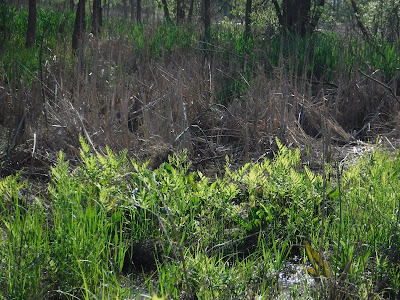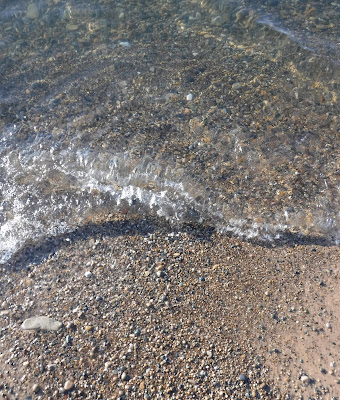The Great Marsh Trail, Redux
Indiana Dunes National Park
May 26, 2019
Richard and I first walked this trail on May 24, 2013. I had been wanting to return to it. How did the last six years go by so quickly?
To see my blog entry from that walk (which was published on September 30, 2019), go to:
https://terriofthetrails.blogspot.com/2013/09/walking-creepy-swamp-great-marsh-trail.html
Within is also a reference to a blog entry I did about the background of the Great Marsh of the Indiana Dunes. The Great Marsh originally stretched between the present-day cities of Michigan City (east) and Gary (west), both in Indiana, at the southern tip of Lake Michigan. It developed between two different dunal formations. There have been interruptions within the stretch of the Great Marsh (mostly from industrialization) over the years, but many segments have been preserved, and restoration efforts are ongoing. The Great Marsh Trail is one segment, near the town of Beverly Shores.
During the first walk we took, the Great Marsh Trail was part of the Indiana Dunes National Lakeshore properties. But, earlier this year those properties became the nation's 61st National Park - Indiana Dunes National Park. It is likely that the park, including this trail, will be receiving more visitors and attention with the change in designation.
What else was different between the 2013 walk and this one?
1. In 2013, the trail was just being formed, part of it not completed, and restoration efforts were fairly new.
2. This time there was much flooding, due to heavy rains over the spring and early summer. We started at the southern trail head but eventually had to turn back. It was impossible to go further without boots, and we were not prepared. We then went to the northern trail head entrance, but ran into the same problem even sooner.
But, there was much to see on that shorter walk. Come along!
Our first view of the Great Marsh Trail this time - this kind of scenery shoots me straight back to my childhood
The southern trail head
Not far from the southern trail head there was a group of yellow irises, which may be the invasive species ....
… but there were also a few of these, which may be the native Blue Flag Iris.
So far, so good
Sensitive Ferns
Common Milkweed
Sterile fronds of Common Horsetail
A marshy opening among the trees - some trees with glowing white trunks
Now it's really getting marshy!
White Birch tree
The large leaves of Skunk Cabbage, which will become huge through the year - a real swamp-loving plant
Another kind of fern - Marsh Fern?? - among Virginia Creeper vines
I still do not know if these are native species of Honeysuckle shrubs, but I am hopeful (I know how terribly invasive the non-native ones can be) - I have not seen non-native Honeysuckle species that look like this pink-flowered one
I was not able to get close enough to these shrubs with their groups of drooping leaves holding clusters of white flowers, but I wonder if they are Wild Hydrangea
Golden Ragwort
A place to reflect
Here, the trail is nicely mowed and looks dry and promising - but, soon we would run into so much water across the trail that we could go no further (though we tried, at first)
A large group of Sensitive Ferns with a backdrop of brown Cat-tails (perhaps the invasive variety of Cat-tail, under control?)
A Beaver was here!! Stay with me as we move to the northern trail head and start again - maybe we'll see a Beaver, and other interesting things!
Into the northern trail: seed stalks of two different plants, left from last year
Horsetail again - this time some fertile stalks
The big swamp, to the northeast, from the observation deck
To the north
To the east/northeast
To the east
And to the east again, but closer ... see that white spot on the right of the vegetation? ... White Egret!
This would be a great place to spend plenty of time with a pair of binoculars.
Let's leave the deck and return to the trail ...
More action! Swimming by, dragging a leafy branch - is it a Beaver, or a Muskrat?
And, now, some various plants that really love growing in the water ...
Various Pondweeds - the smallest flowering plants!
We first encountered these along the other trail. They were drifting by like fluff - much like the fluffy seeds of Cottonwood trees. I noticed the sort of zebra-stripe look to them. Were they plant, or animal? I followed one to where it landed on a plant - then saw it take off from the plant! Definitely animal. Richard noted that it looked like a Cranefly to him. Then, on this other part of the trail, next to the deeper water, we saw them again, and were able to observe them more closely as they landed on the stems and leaves of water plants, still drifting in that unusual manner.
They would tend to take off quickly again after landing, but I was fortunate to get some close-up photos of these strange creatures so that I could look them up later. They are Phantom Craneflies! Unlike other Craneflies, they have swollen parts near the end of each leg that help them to float in the air as they do. Their bodies and wings are tiny and hardly noticeable. According to the sources I checked, they are common around wet places. So, why had I never seen them before, having spent my childhood and much of adulthood around such places? The majority of their lifespan is spent as larvae under the water, using a siphon to catch air through the surface. Their adult life is very brief, when they eat little or nothing, and when their main purpose is to mate.
The Persistence of Life
Richard along the mowed trail. It was soon after this that we encountered another impassable section and had to turn back.
A "nurse log" in the swamp, covered in lichen, moss and tiny plants.
I thought it looked like a whale breaching!
Walking back on the trail, my eye spotted something near the swamp - a Sandhill Crane! You can see it in the center, its neck stretched upward
When I zoomed in, there was one young Crane! Below the adult, just to the right, you can see it's little neck and head craning up over the vegetation.
Here it is again - imitating its parent. But, now you can also see the head of another Sandhill Crane popping up out of the vegetation - to the left, looking the other way.
The first-seen adult, to the right (just off center) is preening its feathers, while the second one, to the left, is still barely visible.
Both Sandhill Crane parents are clearly visible, but the young one has slipped back down toward the ground, out of sight.
We met a woman on the trail who comes here about every day. She said she had, so far, seen two young.
Like we did six years ago after walking the trail, we headed up Broadway and then through the town of Beverly Shores, to the Lakeview overlook and beach. This is where we also like to watch the sun set over the lake, but this time we were a little earlier. However, the views of the lake and dunes were as spectacular as always, and my heart still leaped at that first glimpse of the lake, and every scene afterwards.
That dot of light at the end of the road was our first sight of Lake Michigan during this Dunes trip
Lake Michigan stretches out before us, beyond the Beverly Shores and Lakeview overlooks
There we were, the historic dunal formations behind us, the Great Marsh nestled between those from east to west.
The foredunes, closest to the beach
For me, here, it is all waves of memory.





























































Wonderful, almost like I was there...wait! Lol excellent images.
ReplyDeleteHi, Terri! I came across your blog while doing a google search for a little extra background on the Great Marsh Trail for a reflection I was writing about it. Really appreciated your 2013 essay on the back story. Here's my piece: https://davidrweiss.com/2019/07/12/mucking-along-in-the-great-marsh/
ReplyDelete